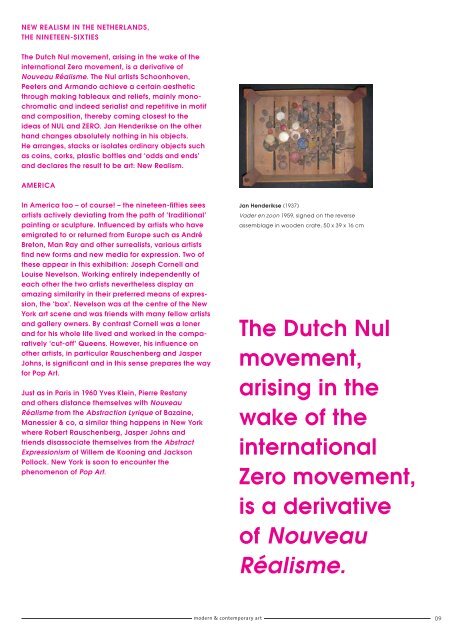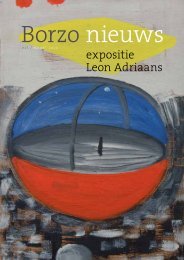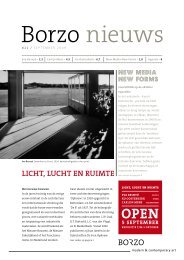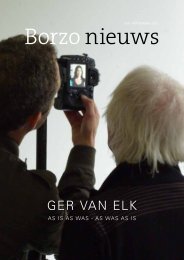nieuw realisme en pop art uit de jaren 60 - Borzo
nieuw realisme en pop art uit de jaren 60 - Borzo
nieuw realisme en pop art uit de jaren 60 - Borzo
Create successful ePaper yourself
Turn your PDF publications into a flip-book with our unique Google optimized e-Paper software.
NEW REALISM IN THE NETHERLANDS,<br />
THE NINETEEN-SIXTIES<br />
The Dutch Nul movem<strong>en</strong>t, arising in the wake of the<br />
international Zero movem<strong>en</strong>t, is a <strong>de</strong>rivative of<br />
Nouveau Réalisme. The Nul <strong>art</strong>ists Schoonhov<strong>en</strong>,<br />
Peeters and Armando achieve a certain aesthetic<br />
through making tableaux and reliefs, mainly monochromatic<br />
and in<strong>de</strong>ed serialist and repetitive in motif<br />
and composition, thereby coming closest to the<br />
i<strong>de</strong>as of NUL and ZERO. Jan H<strong>en</strong><strong>de</strong>rikse on the other<br />
hand changes absolutely nothing in his objects.<br />
He arranges, stacks or isolates ordinary objects such<br />
as coins, corks, plastic bottles and ‘odds and <strong>en</strong>ds’<br />
and <strong>de</strong>clares the result to be <strong>art</strong>: New Realism.<br />
AMERICA<br />
In America too – of course! – the ninete<strong>en</strong>-fi fties sees<br />
<strong>art</strong>ists actively <strong>de</strong>viating from the path of ‘traditional’<br />
painting or sculpture. Infl u<strong>en</strong>ced by <strong>art</strong>ists who have<br />
emigrated to or returned from Europe such as André<br />
Breton, Man Ray and other surrealists, various <strong>art</strong>ists<br />
fi nd new forms and new media for expression. Two of<br />
these appear in this exhibition: Joseph Cornell and<br />
Louise Nevelson. Working <strong>en</strong>tirely in<strong>de</strong>p<strong>en</strong>d<strong>en</strong>tly of<br />
each other the two <strong>art</strong>ists nevertheless display an<br />
amazing similarity in their preferred means of expression,<br />
the ‘box’. Nevelson was at the c<strong>en</strong>tre of the New<br />
York <strong>art</strong> sc<strong>en</strong>e and was fri<strong>en</strong>ds with many fellow <strong>art</strong>ists<br />
and gallery owners. By contrast Cornell was a loner<br />
and for his whole life lived and worked in the comparatively<br />
‘cut-off’ Que<strong>en</strong>s. However, his infl u<strong>en</strong>ce on<br />
other <strong>art</strong>ists, in p<strong>art</strong>icular Rausch<strong>en</strong>berg and Jasper<br />
Johns, is signifi cant and in this s<strong>en</strong>se prepares the way<br />
for Pop Art.<br />
Just as in Paris in 19<strong>60</strong> Yves Klein, Pierre Restany<br />
and others distance themselves with Nouveau<br />
Réalisme from the Abstraction Lyrique of Bazaine,<br />
Manessier & co, a similar thing happ<strong>en</strong>s in New York<br />
where Robert Rausch<strong>en</strong>berg, Jasper Johns and<br />
fri<strong>en</strong>ds disassociate themselves from the Abstract<br />
Expressionism of Willem <strong>de</strong> Kooning and Jackson<br />
Pollock. New York is soon to <strong>en</strong>counter the<br />
ph<strong>en</strong>om<strong>en</strong>on of Pop Art.<br />
mo<strong>de</strong>rn & contemporary <strong>art</strong><br />
Jan H<strong>en</strong><strong>de</strong>rikse (1937)<br />
Va<strong>de</strong>r <strong>en</strong> zoon 1959, signed on the reverse<br />
assemblage in wood<strong>en</strong> crate, 50 x 39 x 16 cm<br />
The Dutch Nul<br />
movem<strong>en</strong>t,<br />
arising in the<br />
wake of the<br />
international<br />
Zero movem<strong>en</strong>t,<br />
is a <strong>de</strong>rivative<br />
of Nouveau<br />
Réalisme.<br />
09





